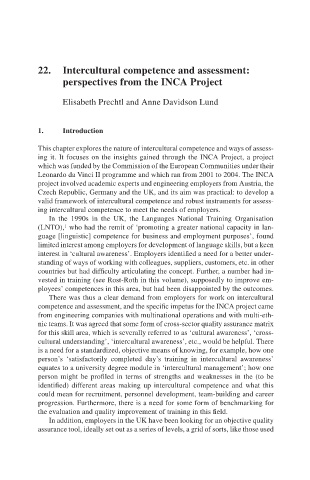Page 489 - Handbooks of Applied Linguistics Communication Competence Language and Communication Problems Practical Solutions
P. 489
Intercultural competence and assessment: perspectives from the INCA Project 467
22. Intercultural competence and assessment:
perspectives from the INCA Project
Elisabeth Prechtl and Anne Davidson Lund
1. Introduction
This chapter explores the nature of intercultural competence and ways of assess-
ing it. It focuses on the insights gained through the INCA Project, a project
which was funded by the Commission of the European Communities under their
Leonardo da Vinci II programme and which ran from 2001 to 2004. The INCA
project involved academic experts and engineering employers from Austria, the
Czech Republic, Germany and the UK, and its aim was practical: to develop a
valid framework of intercultural competence and robust instruments for assess-
ing intercultural competence to meet the needs of employers.
In the 1990s in the UK, the Languages National Training Organisation
1
(LNTO), who had the remit of ‘promoting a greater national capacity in lan-
guage [linguistic] competence for business and employment purposes’, found
limited interest among employers for development of language skills, but a keen
interest in ‘cultural awareness’. Employers identified a need for a better under-
standing of ways of working with colleagues, suppliers, customers, etc. in other
countries but had difficulty articulating the concept. Further, a number had in-
vested in training (see Rost-Roth in this volume), supposedly to improve em-
ployees’ competences in this area, but had been disappointed by the outcomes.
There was thus a clear demand from employers for work on intercultural
competence and assessment, and the specific impetus for the INCA project came
from engineering companies with multinational operations and with multi-eth-
nic teams. It was agreed that some form of cross-sector quality assurance matrix
for this skill area, which is severally referred to as ‘cultural awareness’, ‘cross-
cultural understanding’, ‘intercultural awareness’, etc., would be helpful. There
is a need for a standardized, objective means of knowing, for example, how one
person’s ‘satisfactorily completed day’s training in intercultural awareness’
equates to a university degree module in ‘intercultural management’; how one
person might be profiled in terms of strengths and weaknesses in the (to be
identified) different areas making up intercultural competence and what this
could mean for recruitment, personnel development, team-building and career
progression. Furthermore, there is a need for some form of benchmarking for
the evaluation and quality improvement of training in this field.
In addition, employers in the UK have been looking for an objective quality
assurance tool, ideally set out as a series of levels, a grid of sorts, like those used

